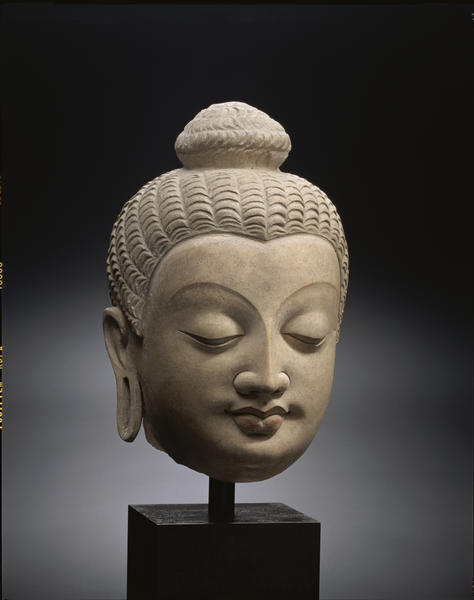仏陀頭部
- ガンダーラ
- 4-5c
- ストゥッコ
ガンダーラの多くの彫像は片岩に彫られたが、やがて造形の容易な塑像-ストゥッコ像が盛んに作られるようになった。中央アジアではこの技法は元来アレクサンドロスの東征以降、ギリシア系の職人によって伝えられたものであり、ガンダーラ地域では主にタキシラに見られるが、殆どの類例はアフガニスタンに集中している。この仏陀頭部の網をかけたような様式化した頭髪表現と、線描で髪の生え際、眉、瞼、首筋などを強調する手法はガンダーラ派ストゥッコ像の典型である。これは等身大以上の像であったと思われる。髷が茸状に立ち上がり、瞼と顔面のつながりが滑らかで深い瞑想の表情を作り出しているが、肉感的でインド・グプタ様式に近いものを感じさせる。造形と描画が組み合わされた微妙でやわらかい慈悲の微笑みをたたえている。
Catalogue Entry
Many Gandhara statues were at first carved on schists, but later, stucco statues, which are easier to make, came to be created in large numbers. The stucco technique was introduced to Central Asia by craftsmen of Greek origin following the eastern expedition of Alexander the Great. In the Gandhara region some examples are found in Taxila, but most are concentrated in Afghanistan. The stylized expression of hair “netted” on the head and the hairline, eyebrows, eyelids, and nape accentuated by lines are typical of Gandhara stucco sculpture. This head fragment may have originally been part of a larger-than-life-size statue. The topknot stands like a mushroom, and the eyelids are connected smoothly to the face, creating a countenance of deep meditation, but at the same time giving it a sensual quality in the Indian Gupta style. With its pleasing combination of forms and lines, the face bears a delicate, gentle, and benevolent smile.
